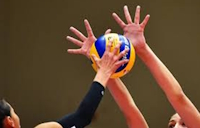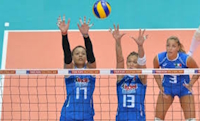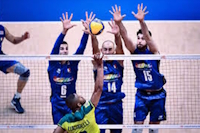





Below are links to training materials for the attacks found online and presented to my athletes during training.
Below are links to the training materials presented to my athletes during training.




Below are links to the training materials presented to my athletes during training.




Blocking is the main defensive action of players at the net to stop or alter an opponent's attack.
Blocking can also be offensive, aiming to completely stop the attack and keep the ball in the opponent's court.
A well-executed offensive block involves jumping and stretching to go over the net with the arms, sticking them out into the opponent's area. It therefore requires anticipating the direction of the ball in attack.
Blocking is part of the fundamentals of the phases of:
The block is classified according to the number of players involved. It can therefore be called a single, double or triple block.
 Single block Single block |
 Double block Double block |
 Muro triplo Muro triplo |
The block is a fundamental that does not present particular technical differentiation, but the needs of the game indicate functional situational adaptation strategies used by the players
The block is not always effective. Furthermore, it is sometimes circumvented with attack systems other than the spike (e.g. lob!).
However, a block that forces the attacker to use different strategies is still very useful.
The position of the block influences the positions in which the other defenders are placed, while the opposing servers spike.
Let's start with what we can define as the fundamental objectives of the block; namely:
These points will reach the greatest effectiveness, the better the execution technique. To be able to perform an effective blocking action, it is not essential to be very tall or jump a lot; that is, it is not the height of the wall that determines its success, but a set of other qualities that involve:
In particular, the evaluation of the most appropriate jump time will be related to the type of construction chosen by the opponent and will determine the precise times of the translocations and jumps!
will be related to the "space" that the wall will have to take.
The six players on a volleyball team have the duty, during the match, to rotate clockwise when their team is receiving and scores while the opponents are serving. Learning to rotate positions is, therefore, fundamental.
The roles in volleyball can be divided into two main fronts: attack and defence. The attack roles are played on the front line, that is, those players who play under the net.
During a volleyball match, there are six players but there is one, called the “libero”, who enters the court when the player occupying the central positions is on the second defence line.
The roles of the players on the court are five:
Page 1 of 2